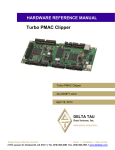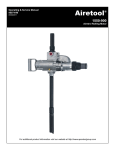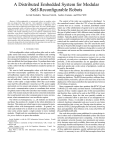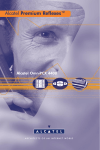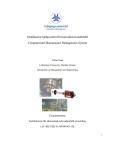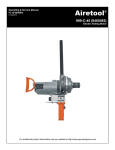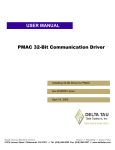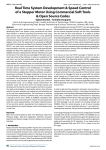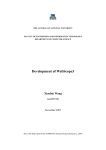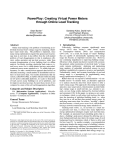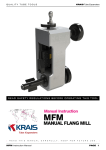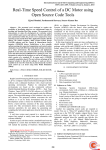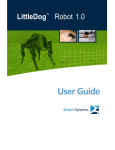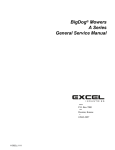Download A real-time walking robot control system based on Linux
Transcript
Proceedings of the 2013 International Conference on Advanced Mechatronic Systems, Luoyang, China, September 25-27, 2013 A real-time walking robot control system based on Linux RTAI Qi Chenkun, Gao Feng State Key Laboratory of Mechanical System & Vibration Shanghai Jiao Tong University Shanghai, China [email protected], [email protected] Deng Liming, Zhao Xianchao State Key Laboratory of Mechanical System & Vibration Shanghai Jiao Tong University Shanghai, China [email protected], [email protected] CAN bus or EtherCAT bus. The bus communication can reduce the connective lines to make the system concise and clear for the connection. Figure 1 shows this structure. Abstract— This study developed a real-time control system for a walking robot. The control system for the walking robot should have a real-time operating system, a small size, and extendable IO cards. The PC104 computer is selected due to its small size, reliability and availability of many IO cards. The Linux RTAI is selected because it is an open-source, efficient and hard real-time operating system. The Turbo PMAC PC104 card is used to control motor drivers because its small size, multi-axis synchronization and powerful control functions. Compared with CAN or EtherCAT bus control scheme, this system can easily support motor drivers from different companies. The software is reusable to different robots due to its independence on communication bus protocols and motor drivers. The motor control experiments are provided to show the satisfactory realtime control performance. Computer BUS Amplifier … Motor … Amplifier Motor Fig. 1 The structure of bus based communication motion control method Keywords—walking robot control; real-time control; PMAC; Linux RTAI; motion control Embedded computer with motion control card. Amplifiers in this system are not directly connect the computer via bus, but connect with the motion control card. While the motion control card connect the computer through standard bus. The computer and controller combination can extend its high performance of calculation in computer and make full use of the controller’s servo control ability. And this control system is friendly to many different kinds of amplifiers. Figure 2 shows the typical structure of this control system. I. Introduction Walking robot, with its flexibility, multi-DOF, better adaptive to unstructured environment, is able to access virtually 100% of the earth’s land surface[1]. Although many research works in this field have been done, scientists are still interested, especially after the Bigdog[2] created by Boston Dynamics, Inc shows its high performance and great potential to the world. Motion control system is the fundamental element to the robot system if motors are chosen as actuators. Almost all the actions of the robot are finally attributed to the movement of the motors, which are implemented by the motion control system. Computer Motion control card Motion control system can be mainly classified into two categories according to the communication method with motor amplifiers. Amplifier … Bus based communication control method. In this control system, algorithms are all integrated into the computer. And the programming need to call a lot of functions from the library provided by motor amplifiers, making the program dependent too much on motor amplifiers. If the motor amplifiers are changed, lots of work should do to change the huge code, which limits the application of this motion control system. The computer communicate with amplifiers via bus, such as Motor … Amplifier Motor Fig. 2 Structure of the computer with motion control card method Through the analysis above, both of the two method are feasible for the walking robot. This work is partially supported by the National Natural Foundation of China (Grant No. 51175323), and National Program on Key Basic Research Project (Grant No. 2013CB035501). 978-0-9555293-9-9/13/$25.00 530 Here, we chose the PC and control card as the motion control system to avoid programming much in low level servo control and for its friendly support to different kind of amplifiers. Linux kernel patched with RTAI, as an open source real-time system, is selected to run in our CPU module. And the control card is Turbo PMAC PC/104 due to its small, compact and highly performance in servo control. Encoders installed on motors give the feedback both to Turbo PMAC and the amplifiers via shield twisted-pair cable, which can improve the anti-interference ability and guarantee the stable of the whole system. Amplifiers receive the analogy signal from Turbo PMAC and supply the power to motors via flat cable. Other sensors directly connect to the Turbo PMAC and also with the A/D card. This paper proposes an implementation of the real-time motion control system for walking robot. Section I is the introduction of this paper, section II introduces the hardware about the system, section III gives a brief introduction about the software of this control system, section IV provides the experiment in the testing of its deterministic timing and also the motor move trajectory, and section V presents the conclusion. II. Controlsystemhardware A. Architecture of the control hardware This control system mainly composed with a motion controller Turbo PMAC, provided by Delta Tau, connected with a industrial PC, and also several amplifiers and motors. To make the system more complementary, many sensors are also added. The industrial PC responds to the high level planning and calculation, such as the trajectory generation, status monitoring, and processes sensor information. Turbo PMAC receives the data from the host PC and control motors by sending command to amplifiers. Figure 3 shows the general hardware architecture of the control system. Figure 4 shows the picture of the real CPU module and Turbo PMAC. ISA BUS Amplifiers Motors PMAC Encoders Fig. 4 The host PC and Turbo PMAC After installed the system, test the system to ensure the connective correctly is necessary according to the Turbo PMAC[3] User Manual’s instruction. Then a lot of stuff, such as frequency, move parameters and .etc, should configure first before make motors rotate well. Another important thing is that tuning the PID parameters. Turbo PMAC provide a PID algorithm, which by far is the most commonly used servo filter[3]. Turbo PMAC also provides extended servo algorithm for more difficult dynamics and allows the users create their own servo algorithm for special occasions. Here, we use the PID servo algorithm, and tuning the parameters by using the PmacTuningPro2, a tool provided by Delta Tau Corporation. … A/D B.2 Test the PMAC system After finishing the connection and configuration of the system, it is nature to test its performance. Turbo PMAC provides powerful and flexible trajectory interpolation algorithm, such as LINEAR mode, SPLINE mode, also PVT mode and so on, which provide customers great autonomy to choose what their want according to their own situations. Sensors Host PC Fig. 3 The architecture of the control system Here, LINEAR mode and PVT mode are chose to test, because LINEAR mode is relative simple and PVT mode will be adopted in our system for its accuracy and excellent contouring capability. The test program is created in the Pewin32Pro2, an integrated development environment, under the instruction of the software manual[4] and user manual. B. PMAC motion control system B.1 Establish the PMAC system As the Fig.3 shows, the host computer connect with the Turbo PMAC via ISA bus, other cards with this bus such as A/D card also can be extended in the system. Each Turbo PMAC can control four motors. With the help of ACC-1P (an expansion of the PMAC), the Turbo PMAC can control up to 12 motors which can cover the requirement of our walking robot. In the test program, the motor is required to move a cosine function, with 100 position interpolation, the time of each position interval is fixed. However, the LINEAR mode has acceleration and deceleration time at the first and the end point, while the PVT mode enwrap acceleration and deceleration time in the fixed time, thus the LINEAR mode takes a little 978-0-9555293-9-9/13/$25.00 531 more time than the PVT mode. Figure 5 and Figure 6 show the result of following required trajectory in two modes. Remote GUI Signal Gathering Main Real-time System PMAC Fig. 5 Position and velocity profiles in LINEAR mode Trajectory Planning Command Sending Fig.7 The architecture of the control software B. Linux and RTAI A real-time computer system can be defined as a system that performs its functions and responds to external, asynchronous events within a specified amount of time[5]. The real-time system can be divided into soft and hard real-time system. A Linux system can be regarded as a soft real-time system, while the hard real-time system should guarantee the deadlines critically. Many task such as rocket launching control should guarantee the time, much delay will cause a disaster. Fig. 6 Position and velocity profiles in PVT mode There are many real-time operating systems available today, such as QNX, VxWorks, RTLinux, RTAI, Xenomai, Linux. QNX and VxWorks are commercial real-time system, RTLinux also has patent limitations. Xenomai and RTAI patched in Linux kernel are both free and open source project and can represent a validate alternative for the commercial real-time system. While the RTAI proved to be has slightly better performance than Xenomai[6]. Here, Real Time Application Interface (RTAI), as an open, supported, standard, efficient and free system with hard real-time capability, is chosen to control our robot. In the upper figures, the red profile represent the position and the green profile represent the velocity during the motion. It shows that motors controlled by this system have good following capabilities and little vibration. At this point, the connection and the essential configuration for the PMAC have been successfully finished. Thus, we can turn to the next part to discuss the real-time operating system and the application program. III. Real‐timecontrolsoftware RTAI is integrated into Linux through a text file containing a set of changes to its kernel source code, known as a patch, and a series of add on programs expanding Linux to hard real time by installing a generic Real Time Hardware Abstraction Layer (RTHAL)[7]. Figure 8 shows the simplified structure of the real-time system. A. Architecture of the control software In the real-time system, the control software is mainly consist of four kinds threads, as shows in Figure 7. The main thread is response for initial and delete all the other threads. The signal gathering threads are trying to gather the signal from different sensors in a fixed frequency. Some of these kind threads send part of the data to remote GUI for monitoring, while others collecting the key information from the sensors and sending data to trajectory planning thread. The trajectory planning thread is the core of the control software. On one hand, it incorporate all the relative sensors’ signals and process them as desired. On the other hand, it also can receive and response the commands from the remote GUI. The trajectory planning thread is aim to generate the desired positions or velocities for motors, and these data will be sent to the PMAC for control motors to targeted position by command sending thread. The arrow with straight line in Figure 7 means that the time for this process should be deterministic and guaranteed. The RTHAL enwraps all the hardware interrupts and dispatches them to standard Linux or to real-time tasks depending on the requirements of the RTAI schedulers. The RTAI distribution includes three different priority based, pre-emptive real time schedulers: the Uni-Processor (UP) scheduler; the Multi Uni-Processor (MUP) scheduler; and the Symmetric Multi-Processor (SMP) scheduler. It is generally not necessary for the user to manually install the proper scheduler because the installation process is usually able to determine the appropriate scheduler from the hardware configuration of the target machine. It then copies and links the appropriate scheduler so that it is called by the generic rtai_sched reference. 978-0-9555293-9-9/13/$25.00 532 Non RT-Task Linux Kernel FIFO MBX … IV. MotionControlExperiments RT-Task In the control system, the rotary buffer provided by Turbo PMAC is used to receive the command lines generated from the host computer. And motors move as the rotary buffer instructed. If the motor finished to execute one command, the command line stored in the rotary buffer will be discarded leave new room for new command line. What we want to guarantee is that the command lines in rotary buffer should not too many, or the control object (here is robot) will have a long delay in interacting with the environment. And at least one command line stored in case to avoid motor stop without the command. These sending and consuming mechanism is shown in Figure 9. Real-time Kernel Scheduler Software Interrupts Hardware Real-time Hardware Abstraction Layer Interrupts Hardware: Interrupt Controller Rotary Buffer Fig. 8 The structure of the Linux RTAI Consumer The scheduling policy for RTAI are EDF(Earliest Deadline First), FIFO(First In First Out), RR(Round Robin), RMS(Rate-Monotonic Scheduling). The FIFO is the default scheduling policy for real time task. While Linux scheduler defaults to SCHED_OTHER , which is a time-sharing policy most commonly used by Linux processes. SCHED_FIFO used to gain a greater level of control over the way in which the process is scheduled. Using this policy allows the process to preempt any other process scheduled using SCHED_OTHER and any process with a lower priority. Generator Command Lines Fig. 9 Generating and consuming mechanism Figure 10 shows the core program flow chart programmed in the upper computer. This thread should run in hard real-time to make it always have highest priority and not preempted by other non real-time task. Other threads such as display the motor status or print the progress of the real-time task are not showed in the chart. RTAI enable the hard real time task both in kernel space and user space. The two strategies offer both positives and negative aspects[8]. For the user mode is more simple and convenient to implement. RTAI’s services are provided by several modules, which allow hard real-time, fully preemptive scheduling based on a fixed priority scheme. The some modules are[9]: Start Initial Thread rtai - the basic RTAI framework, plus interrupt dispatching and timer support. Initial RT-Task rtai_sched – the real-time, pre-emptive, priority-based scheduler, chosen according to the hardware configuration. Trajectory Generate rtai_fifos – FIFOs and semaphores. Send Command rtai_shm – shared memory. lxrt – LXRT for user space Yes With these modules, some related functions can be called to implement the hard real-time task. After loading the modules, there is no much difference to program it with respect to general process, except calling the special function provided by RTAI to make it hard real-time. Be sure to start the timer once in a process. Then lock the memory, initial the task and make it to real-time task. The hard real-time task should not include a lot of task. The performance of hard real-time task can be guaranteed as few as possible. More hard real-time tasks may change them into soft real time. More detail instructions about how to program in Linux RTAI can be found in the DIAPM RTAI programming guide[9]. Continue? No End Fig. 10 The core program flow chart In the motion control, PVT mode is chosen and set the time to 10 millisecond. It means the motor execute one command line will takes 10 millisecond. Thus, within this time, the host computer first should generate the desired 978-0-9555293-9-9/13/$25.00 533 From TABLE II, we can see that the sending time is very small, and the whole loop time also can be guaranteed within 20 milliseconds. position and velocity and then send it to the rotary buffer. The generation takes very few times about 50 micro second. However, when sending the command to rotary buffer, the time cannot be guaranteed. A small problem should be paid attention is that the timer in the host computer is not exactly the same with the PMAC, thus before put the system into use, calibrate the timing is necessary. To be frank, using the interrupt would be a more elegant way to solve the problem fundamentally. TABLE I shows 10 longest times in sending the command to rotary buffer. The first column indicates in which loop it happens, and the second column shows the exacting time in sending the command, and the last column shows the whole loop takes to finish the task. TABLE I. V. Conclusion TEN LONGEST SENDING TIME IN NON-REALTIME DRIVER TEST No. Send time(us) The Loop time(us) 14702 99194.982 99950.93 29934 92281.577 93071.001 29935 2533.993 4961.279 29936 5393.154 6323.824 45404 89387.038 90140.051 45406 2400.429 4816.463 47326 3851.072 19986.412 47426 3469.209 19978.858 62921 84512.758 87151.302 78209 100845.156 102220.363 The aiming of the reported work is trying to implement a real-time motion control system for walking robot. The RTAI provide a good solution to the real-time operating system to guarantee the algorithm calculation time before deadline. With the extension of the real-time driver for Turbo PMAC, the communication between PMAC and host computer is also have the deterministic time. The PMAC has good performance to control the motors both in accuracy and fast response. Lots of tests have proved that the time from the algorithm calculation to motors execution can be guaranteed. And this control system can satisfy the requirement of the complex walking robot both with fast response and quick interaction with the environment. Acknowledgment During the time in implementing this real-time control system, many technique supports from Delta Tau help us configure the PMAC and also its programming, and Paolo Mantegazza help us modify the PMAC driver to real-time type, which make it possible to guarantee the time in the communication. And Giulio Cerrtui, also help us to create a lot of code. In this test, it continues half an hour and about 90000 cycles in total, two command lines are send in each loop, and the hard real-time task is executed in periodic mode, set 20 milliseconds a cycle. It is obvious that the time cannot be guaranteed. In the 78209th loop, the sending time even exceed one hundred milliseconds, which is not allowed in the control system. This happens because the driver of the PMAC is not a realtime driver. After a hard experience changing it to real-time driver, the deterministic time can be guaranteed. TABLE II also shows the ten longest times in sending the command to rotary buffer after change the driver to real-time type. References [1]. [2]. TABLE II. TEN LONGEST SENDING TIME IN REALTIME DRIVER TEST No. Send time(us) The Loop time(us) [3]. 34473 324.045 19988.128 [4]. 49467 323.973 19988.278 56342 328.384 19988.11 63245 324.345 19988.335 70134 328.062 19987.937 77123 324.278 19988.387 84240 328.162 19988.32 84664 324.255 19988.358 84833 328.654 19988.406 84909 324.483 19988.445 [5]. [6]. [7]. [8]. [9]. 978-0-9555293-9-9/13/$25.00 534 Zico Kolter J, Ng A Y. The Stanford LittleDog: A learning and rapid replanning approach to quadruped locomotion[J]. The International Journal of Robotics Research, 2011, 30(2): 150-174. Raibert M, Blankespoor K, Nelson G, etc. BigDog, the Rough-Terrain Quadruped Robot [J]. The International Federation of Automatic Control, 2008. DELTA TAU Data Systems I. USER MANUAL for Turbo PMAC[M]. 2008. DELTA TAU Data Systems I. SOFTWARE REFERENCE MANUAL for Turbo PMAC/PMAC2 [M]. 2010. Furht B, Grostick D, Rabbat G, etc. Real-Time UNIX System: Design and Application Guide[M]. Kluwer Academic Publishers, 1990. Barbalace A, Luchetta A, Manduchi G, etc. Performance comparison of VxWorks, Linux, RTAI and Xenomai in a hard real-time application[A]. In Real-Time Conference, 2007 15th IEEE-NPSS[C], 2007: 1-5. Dozio L, Mantegazza P. Real time distributed control systems using RTAI[A]. In Object-Oriented Real-Time Distributed Computing, 2003. Sixth IEEE International Symposium on[C], 2003: 11-18. Racciu G, Mantegazza P. RTAI User Manual 3.4[M]. October, 2006. Mantegazza P, Bianchi E, Angelo M, etc. DIAPM RTAI programming guide 1.0[M]. 2000.





